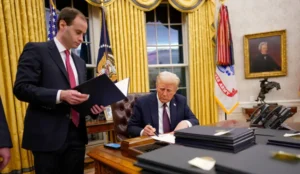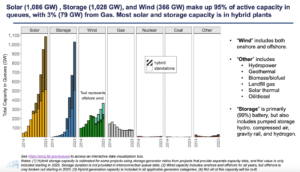Welcome to 2025, and to the year of the snake (Happy Lunar New Year to those who celebrate – I ate dumplings with my kids). This month, we’re talking about new uncertainty in federal policy with the Trump administration taking office, a look back at trends and highlights from 2024, a new approach to encouraging new transmission, interconnection queues, and more!
 Credit: Jabin Botsford /The Washington Post via Getty Images
Credit: Jabin Botsford /The Washington Post via Getty Images
A New Normal in DC
With a new administration taking office, there has been a lot of activity and coverage, but a lot of uncertainty remains. It seems clear that offshore wind (which relies on federal permitting approvals) is going to be slowed significantly, but many other areas are less clear. For example, the Trump administration halted on-shore wind projects on federal lands, but more than 99% of them take place on private land, and are overwhelmingly located in districts that are represented by Republicans, who have a lot of skin in the game in new wind development for job creation and tax revenue reasons.
Moves to halt grant funding have been chaotic for many stakeholders, especially early-stage companies that are reliant on federal grants for R&D activities, although that halt was itself halted by a court order.
And whatever is said about how the administration is going to eliminate IRA spending, that is not how it actually works – a new law needs to be passed, through reconciliation, to change those subsidy levels or eliminate specific programs. I think it is likely that some reconciliation package will indeed be passed that does impact the IRA of course, but just saying it is stopped doesn’t make it true (although a bunch of things are certainly uncertain or delayed pending additional clarity from the administration and/or courts).
One other tension I see in early administration moves is between pushing for more oil and gas production and for lower prices. In the US, we’re already at record levels of fossil fuel production, and oil and gas companies have more fiscal discipline than in the past. More production is very feasible of course, but a lot of it requires consistently higher prices to be economic (so it’s hard to get both dramatically more production and significantly lower prices at the same time, all else equal).
I think the though line on federal activity will be uncertainty this year – due to pauses, delays, and court cases, due to conflicting statements and actions, and due to what is likely to be topsy-turvy process to finalize reconciliation legislation given the very narrow majority Republicans hold in the house.
Memory Lane: 2024 Year in Review
January brings with it a number of sources of data on the year that we just left. Qualitatively, there was a lot of activity and coverage around new nuclear, load growth from AI and data centers, geothermal, and carbon dioxide removal.
Quantitatively, we saw climate tech venture deals fall for the third straight year, although this data is nuanced. At the early stages (seed/A) deal counts are down, but capital deployed is actually up compared to last year. And by sector, CTVC shared that investments in the transportation and industry themes fell by around 80% compared to last year.
One of my favorite annual recap reports is the Volta Foundation Battery Report, which is a seemingly impossibly detailed look into all elements of the battery and electric vehicle industry. The report is great reading, but everyone has time for this highlight summary from the report. One thing that jumped out from their lead stat was the dichotomy between overall global growth, and more modest growth domestically. Globally, sales of battery electric vehicles (including hybrids) grew 25%, and in China, make up 45% of new car sales. In North America, they are also growing, but much more gradually (and are actually declining slightly in Europe as some incentives have been eliminated).

IL Came in Like A RECing Ball
Illinois is considering legislation that would enable merchant transmission developers to get subsidies from the state’s renewable energy credits program, given their importance and complementarity to developing renewables projects. Policy to promote transmission should absolutely be at the federal level primarily (because most merchant lines cross state lines), but I think it is positive that Illinois is exploring creative approaches to address the challenges of building transmission (and it’s better than nothing). It could be money very well spent- the issue (at least until very recently) has not been the amount of new renewables projects being planned, it has been the ability to interconnect them (which is, dare I say, interconnected to transmission bottlenecks, among other things).
Who Builds What?
 Credit: Lawrence Berkeley National Lab
Credit: Lawrence Berkeley National Lab
Fun fact -the US interconnection queue to connect new projects (2.6TW) is twice the installed capacity of the entire country, and it is almost entirely renewables, with solar and storage making up over 80% of this queue. It won’t all get built, of course, but gives you a sense of where the industry is currently heading. There is a lot of attention currently on next generation nuclear and geothermal, especially with the administration change in DC and its focus on “baseload” power. I hope that these are huge growth areas over the next two decades, but it is worth remembering that essentially all of the action is in renewables and storage today (and globally, there’s also a bunch of nuclear power getting built – over 70 gigawatts under construction currently, half in China).
Where We’re Going, We Don’t Need Divers
Michigan based autonomous vehicle telematics provider May Mobility announced a partnership with Technobus at CES for a new autonomous EV bus that can seat up to 30 people. I have long been bullish on autonomous mini-buses as a solution that will unlock the real value and impact of autonomous vehicles for cities. Autonomous taxis are great too, but so far appear to be slightly better/cheaper forms of ride shares, and are improving, but not necessarily fundamentally changing transportation dynamics in cities.
Jumpin’ Jack Flash It’s a gas! Gas! Gas!
Energy Dome is deploying its first commercial scale long duration (10 hour) energy storage plant on the Italian island of Sardinia, using CO2 as a working fluid
And I would have gotten away with it too if it weren’t for your meddling robots
Someone tried to rob a store and get away in a robot AKA Waymo autonomous taxi. The perfect crime – no witnesses! No one to snitch! Unfortunately the Waymo pulled over immediately when the police turned on their lights. Nice try, supervillain.